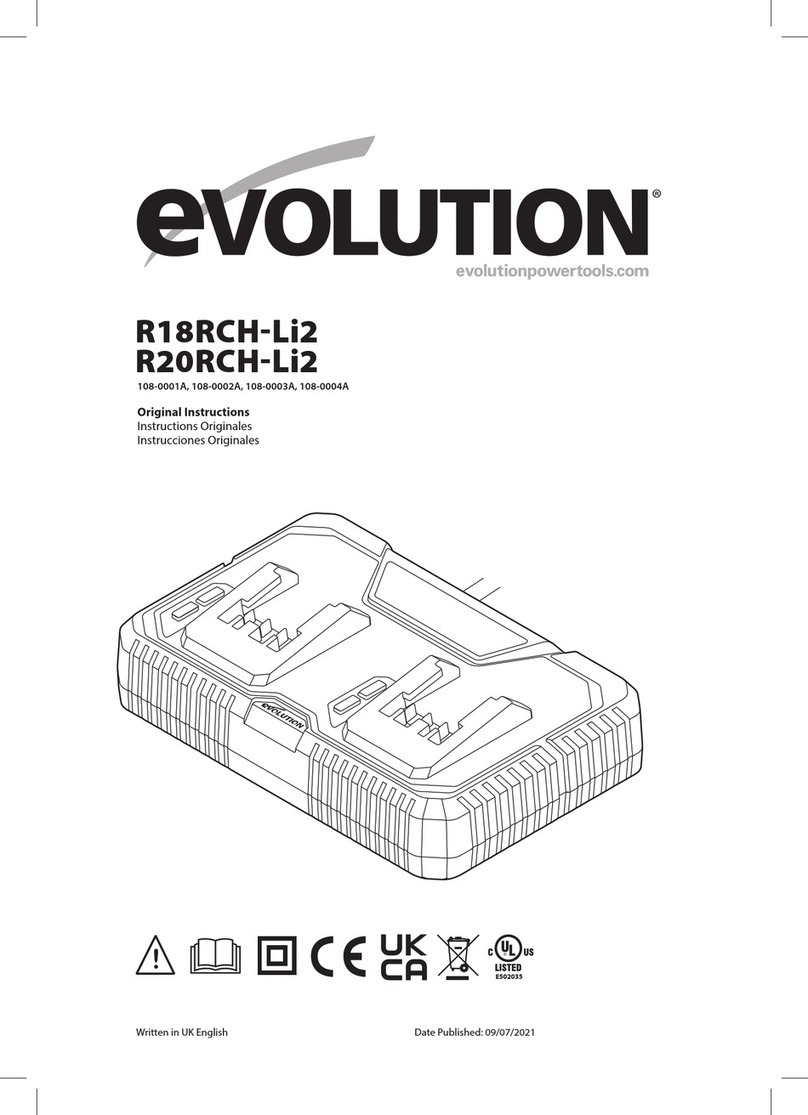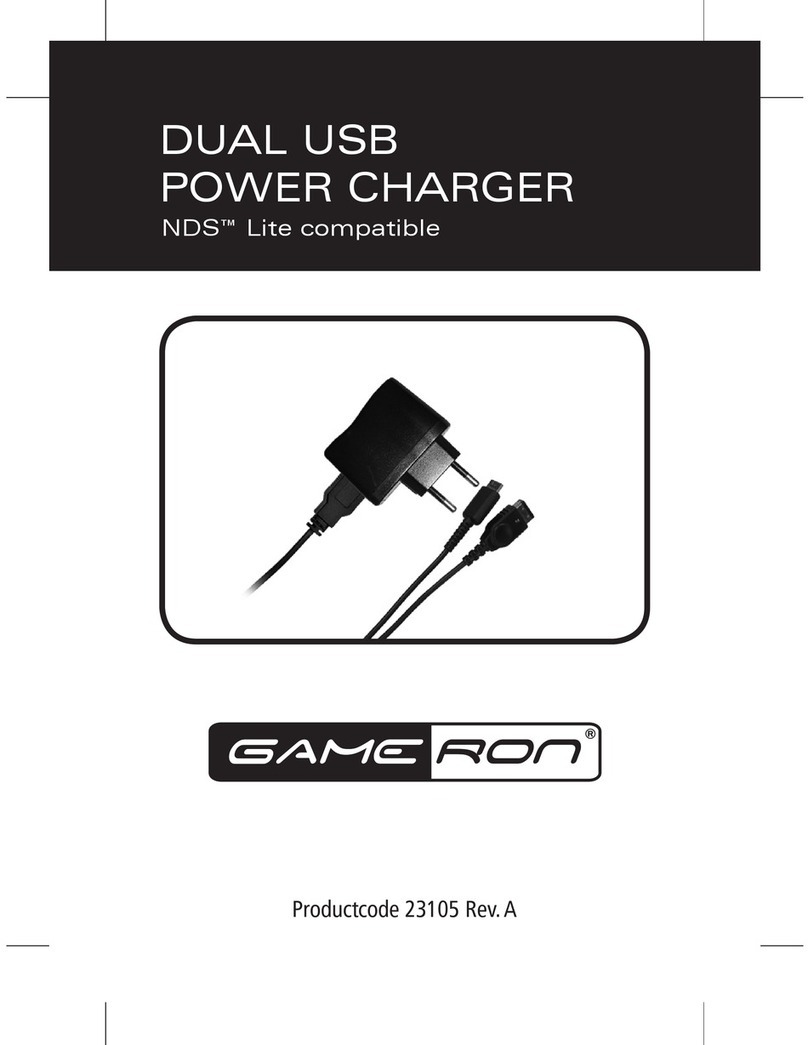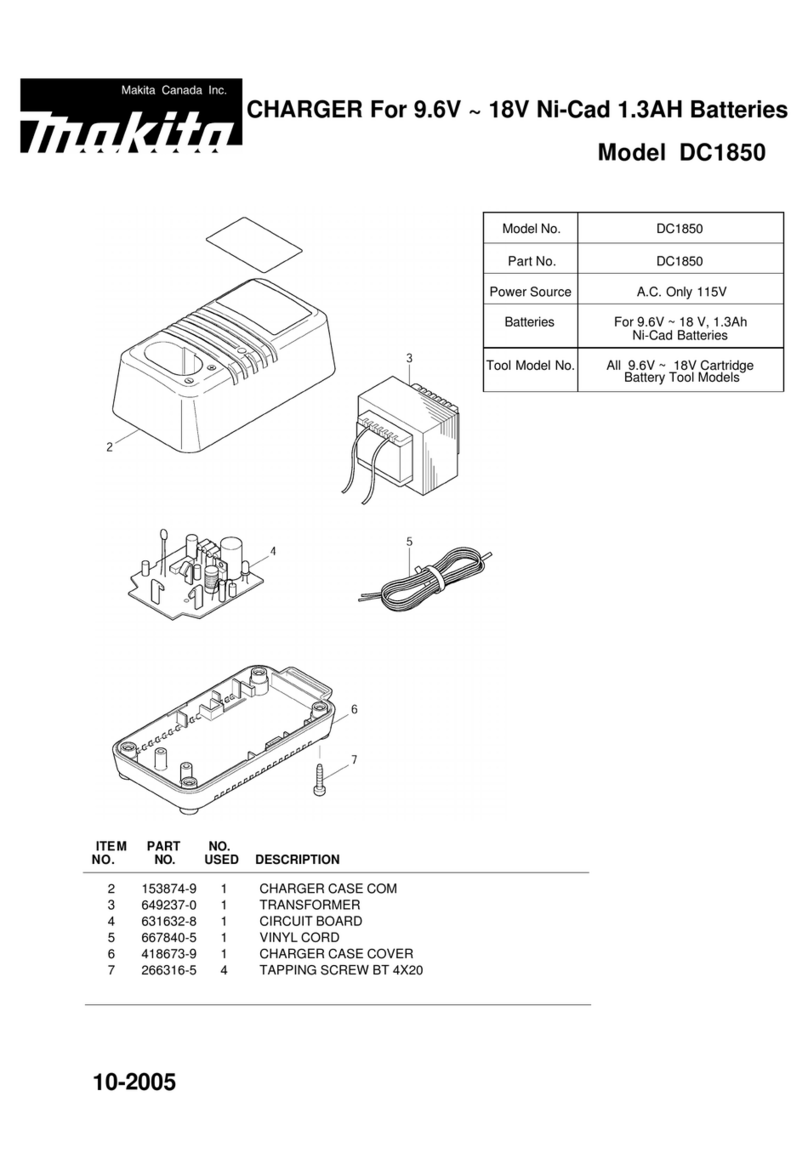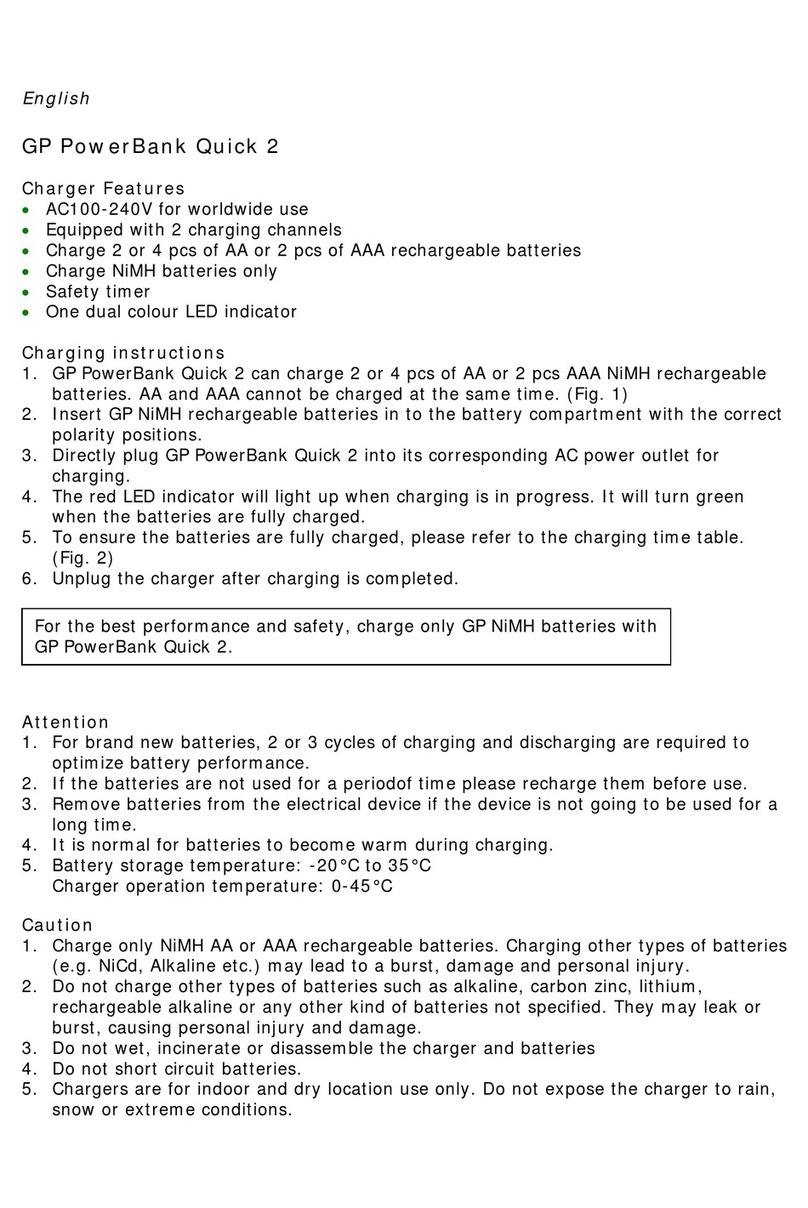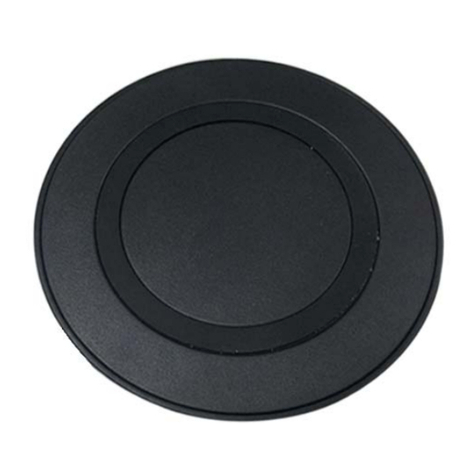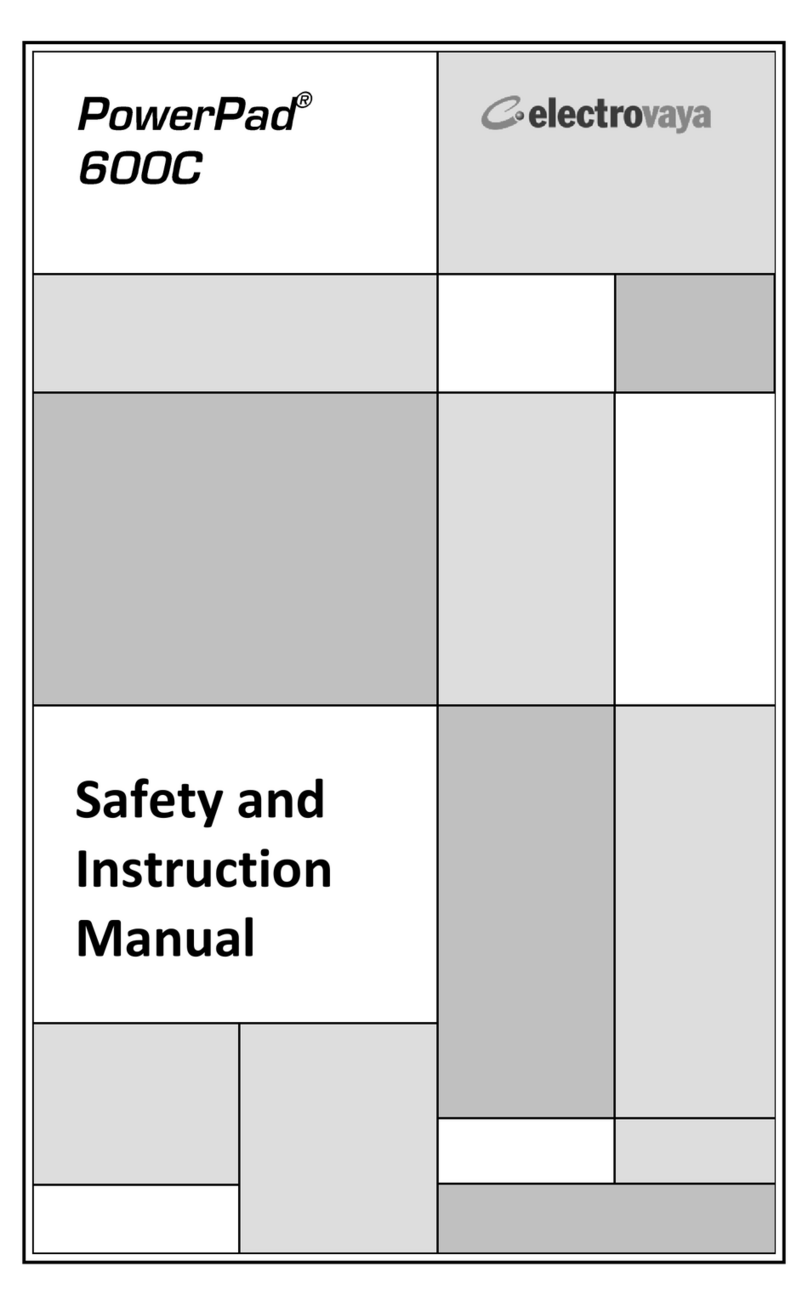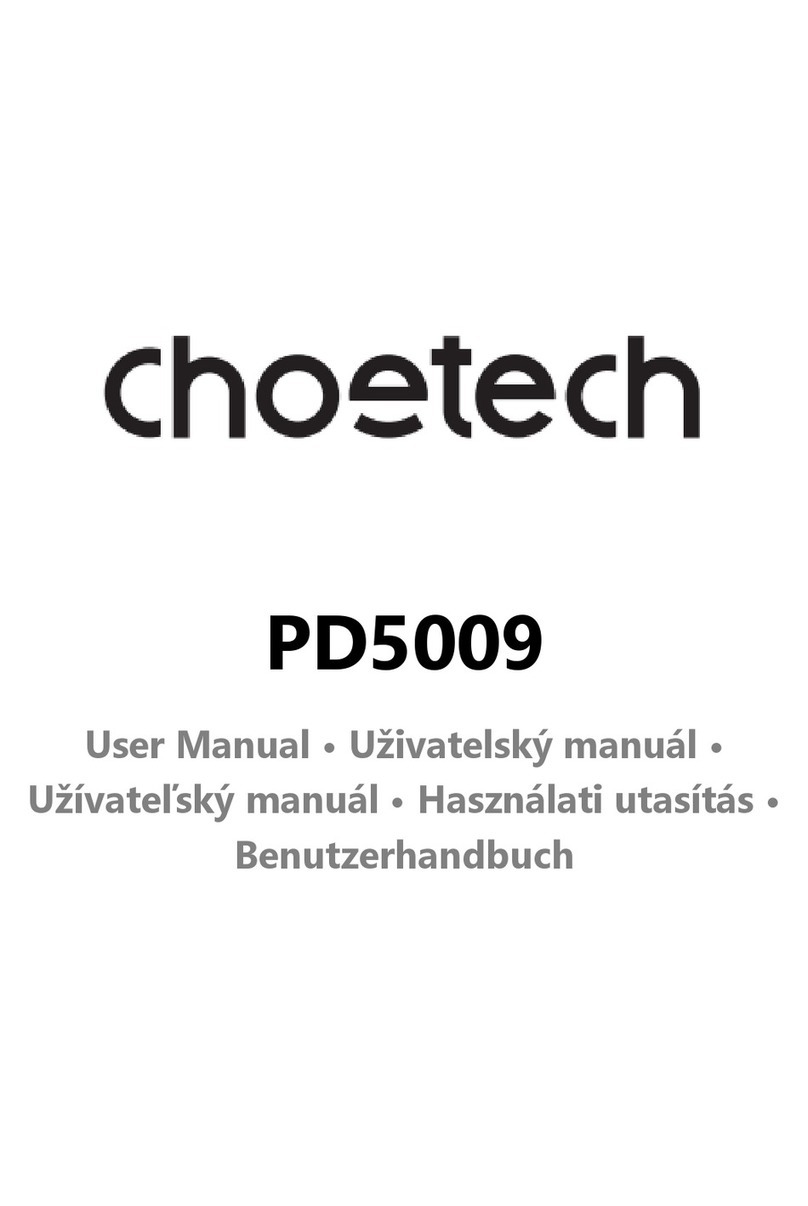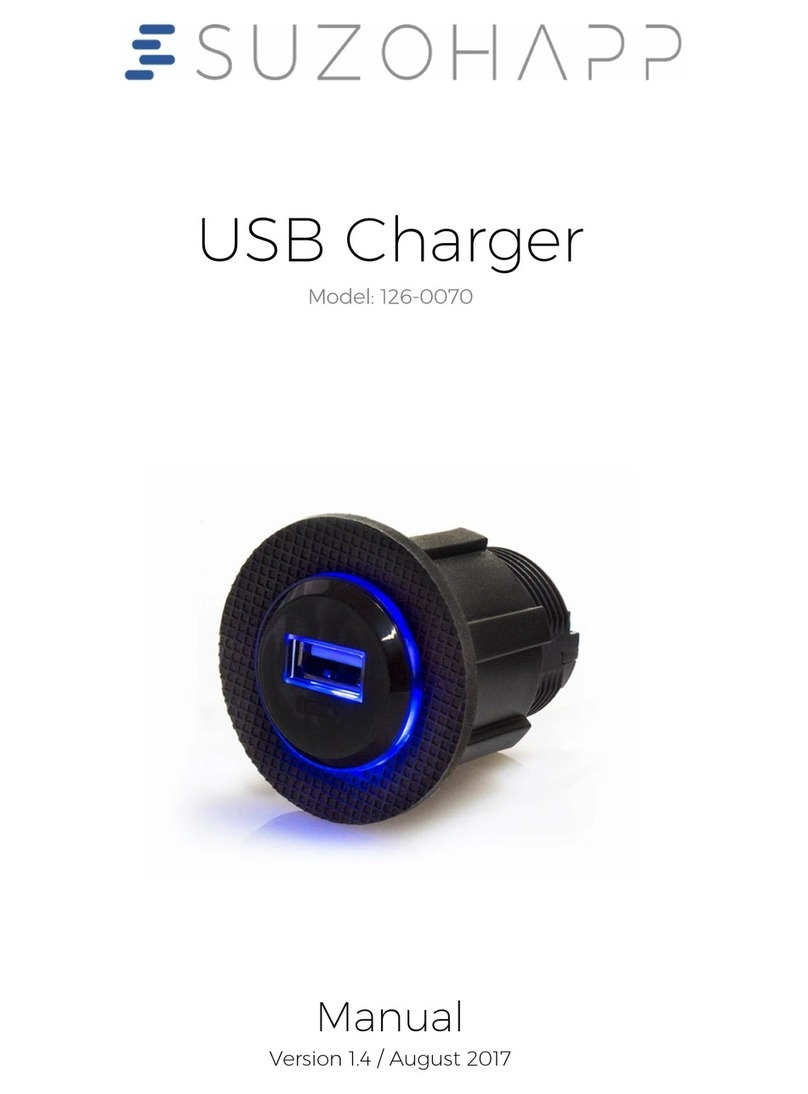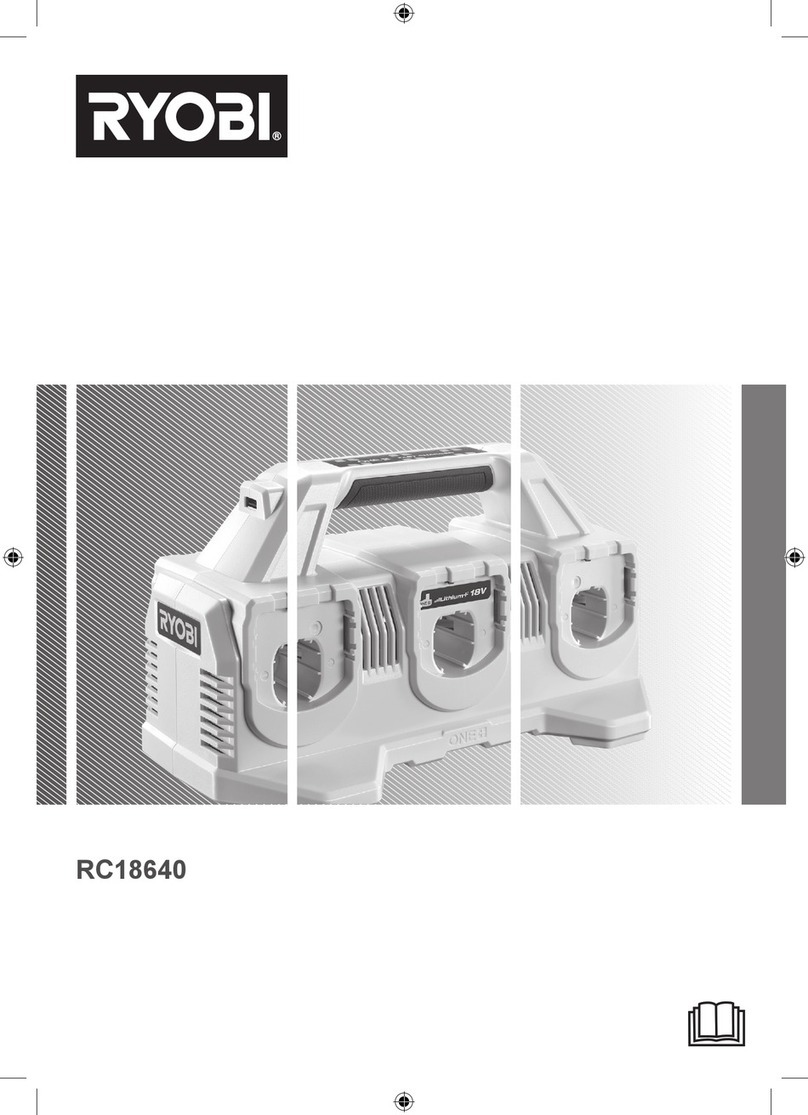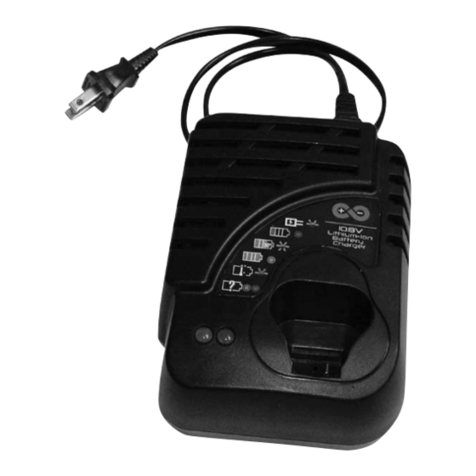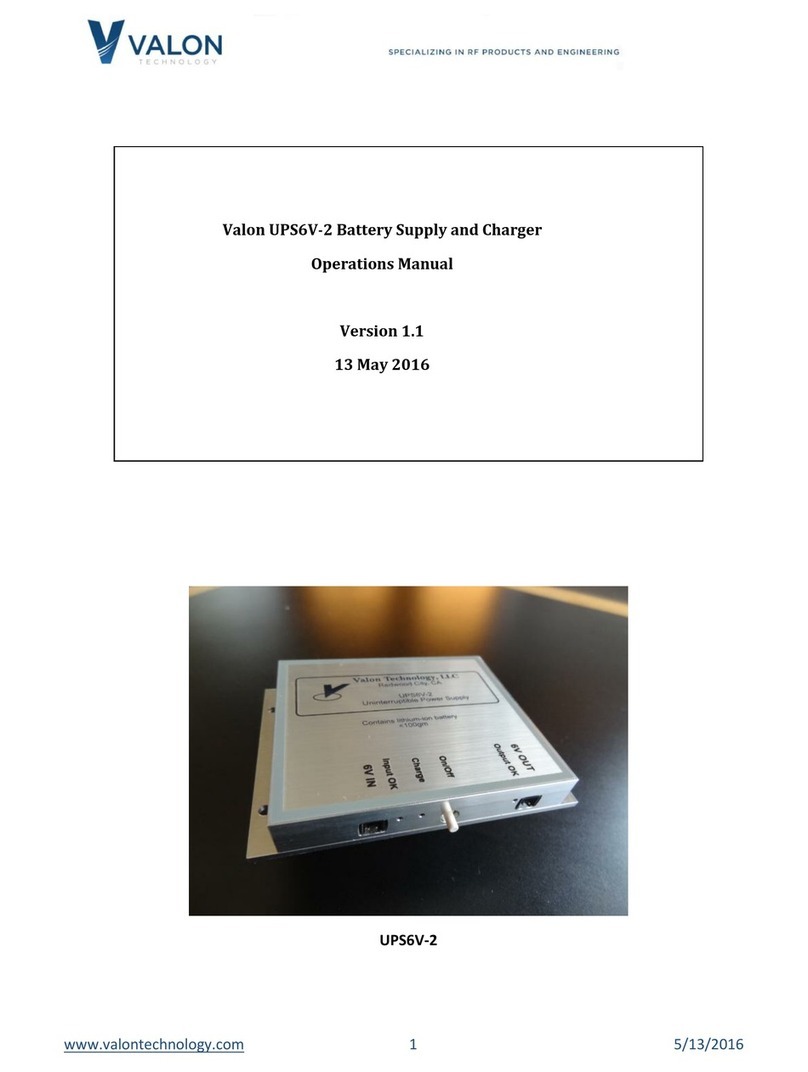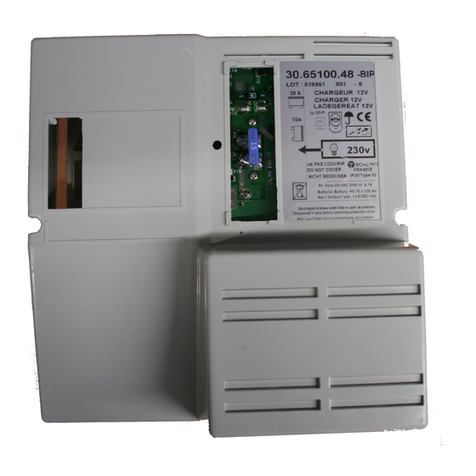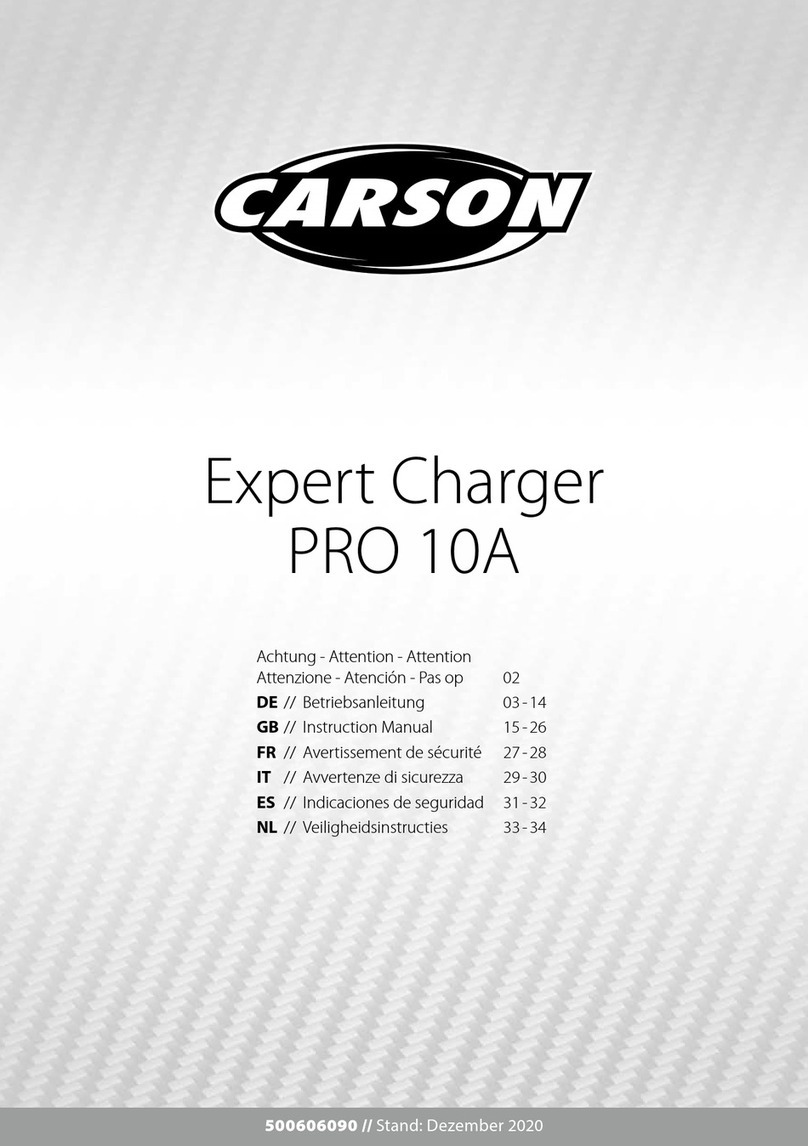Deltran Battery Tender Junior User manual

1
IMPORTANT SAFETY INSTRUCTIONS
1) SAVE THESE INSTRUCTIONS
2) Do not expose charger to rain or snow.
3) Use of an attachment not recommended or sold by the battery charger manufacturer may
result in a risk of fire, electric shock, or injury to persons.
4) To reduce risk of damage to electric plug and cord, pull by plug rather than cord when
disconnecting charger.
5) An extension cord should not be used unless absolutely necessary. Use of improper
extension cord could result in a risk of fire and electric shock. If an extension cord must
be used, make sure:
a) That pins on plug of extension cord are the same number, size, and shape as those of
plug on charger;
b) That extension cord is properly wired and in good electrical condition; and
c) That wire size is large enough for ac ampere rating of charger as specified in Table 1
6) Do not operate charger with damaged cord or plug – replace the cord or plug
immediately.
7) Do not operate charger if it has received a sharp blow, been dropped, or otherwise
damaged in any way; take it to a qualified serviceman.
8) Do not disassemble charger; take it to a qualified serviceman when service or repair is
required. Incorrect reassembly may result in a risk of electric shock or fire.
9) To reduce risk of electric shock, unplug charger from outlet before attempting any
maintenance or cleaning. Turning off controls will not reduce this risk.
10) WARNING – RISK OF EXPLOSIVE GASES.
a) WORKING IN VICINITY OF A LEAD-ACID BATTERY IS DANGEROUS.
BATTERIES GENERATE EXPLOSIVE GASES DURING NORMAL BATTERY
OPERATION. FOR THIS REASON, IT IS OF UTMOST IMPORTANCE THAT YOU
FOLLOW THE INSTRUCTIONS EACH TIME YOU USE THE CHARGER.
b) To reduce risk of battery explosion, follow these instructions and those published by
battery manufacturer and manufacturer of any equipment you intend to use in
vicinity of battery. Review cautionary marking on these products and on engine.
11) PERSONAL PRECAUTIONS
a) Consider having someone close enough by to come to your aid when you work near
a lead-acid battery.
b) Have plenty of fresh water and soap nearby in case battery acid contacts skin,
clothing, or eyes.
c) Wear complete eye protection and clothing protection. Avoid touching eyes while
working near battery.
d) If battery acid contacts skin or clothing, wash immediately with soap and water. If
acid enters eye, immediately flood eye with running cold water for at least 10
minutes and get medical attention immediately.
e) NEVER smoke or allow a spark or flame in vicinity of battery or engine.
Deltran Battery TenderJunior
Designed for six cell lead-acid batteries
TABLE 1
Length of Cord, Feet 25 50 100 150
AWG Size of Cord 18 18 18 16
P/N 392-0247-RE 2
f) Be extra cautious to reduce risk of dropping a metal tool onto battery. It might spark
or short-circuit battery or other electrical part that may cause explosion.
g) Remove personal metal items such as rings, bracelets, necklaces, and watches
when working with a lead-acid battery. A lead-acid battery can produce a short-
circuit current high enough to weld a ring or the like to metal, causing a severe burn.
h) Use charger for charging a LEAD-ACID battery only. It is not intended to supply
power to a low voltage electrical system other than in a starter-motor application. Do
not use battery charger for charging dry-cell batteries that are commonly used with
home appliances. These batteries may burst and cause injury to persons and
damage to property.
i) NEVER charge a frozen battery.
12) PREPARING TO CHARGE
a) If necessary to remove battery from vehicle to charge, always remove grounded
terminal from battery first. Make sure all accessories in the vehicle are off, so as not
to cause an arc.
b) Be sure area around battery is well ventilated while battery is being charged.
c) Clean battery terminals. Be careful to keep corrosion from coming in contact with
eyes.
d) Add distilled water in each cell until battery acid reaches level specified by battery
manufacturer. Do not overfill. For a battery without removable cell caps, such as
valve regulated lead acid batteries, carefully follow manufacturer’s recharging
instructions.
e) Study all battery manufacturer’s specific precautions such as removing or not
removing cell caps while charging and recommended rates of charge.
f) Determine voltage of battery by referring to car owner’s manual. Do not use the
battery charger unless battery voltage matches the output voltage rating of the
charger.
13) CHARGER LOCATION
a) Locate charger as far away from battery as dc cables permit.
b) Never place charger directly above battery being charged; gases from battery will
corrode and damage charger.
c) Never allow battery acid to drip on charger when reading electrolyte specific gravity
or filling battery.
d) Do not operate charger in a closed-in area or restrict ventilation in any way.
e) Do not set a battery on top of charger.
14) DC CONNECTION PRECAUTIONS
a) Connect and disconnect dc output clips only after setting any charger switches to
offposition and removing ac cord from electric outlet. Never allow clips to touch
each other.
b) Attach clips to battery and chassis as indicated in 15(e), 15(f), and 16(b) through
16(d).
15) FOLLOW THESE STEPS WHEN BATTERY IS INSTALLED IN VEHICLE. A SPARK
NEAR BATTERY MAY CAUSE BATTERY EXPLOSION. TO REDUCE RISK OF A
SPARK NEAR BATTERY:
a) Position ac and dc cords to reduce risk of damage by hood, door, or moving engine
part.
b) Stay clear of fan blades, belts, pulleys, and other parts that can cause injury to
persons.
c) Check polarity of battery posts. POSITIVE (POS, P, +) battery post usually has
larger diameter than NEGATIVE (NEG, N,–) post.
d) Determine which post of battery is grounded (connected) to the chassis. If negative
post is grounded to chassis (as in most vehicles), see (e). If positive post is
grounded to the chassis, see (f).
e) For negative-grounded vehicle, connect POSITIVE (RED) clip from battery charger
to POSITIVE (POS, P, +) ungrounded post of battery. Connect NEGATIVE (BLACK)
clip to vehicle chassis or engine block away from battery. Do not connect clip to
carburetor, fuel lines, or sheet-metal body parts. Connect to a heavy gage metal
part of the frame or engine block.

1
IMPORTANT SAFETY INSTRUCTIONS
1) SAVE THESE INSTRUCTIONS
2) Do not expose charger to rain or snow.
3) Use of an attachment not recommended or sold by the battery charger manufacturer may
result in a risk of fire, electric shock, or injury to persons.
4) To reduce risk of damage to electric plug and cord, pull by plug rather than cord when
disconnecting charger.
5) An extension cord should not be used unless absolutely necessary. Use of improper
extension cord could result in a risk of fire and electric shock. If an extension cord must
be used, make sure:
a) That pins on plug of extension cord are the same number, size, and shape as those of
plug on charger;
b) That extension cord is properly wired and in good electrical condition; and
c) That wire size is large enough for ac ampere rating of charger as specified in Table 1
6) Do not operate charger with damaged cord or plug – replace the cord or plug
immediately.
7) Do not operate charger if it has received a sharp blow, been dropped, or otherwise
damaged in any way; take it to a qualified serviceman.
8) Do not disassemble charger; take it to a qualified serviceman when service or repair is
required. Incorrect reassembly may result in a risk of electric shock or fire.
9) To reduce risk of electric shock, unplug charger from outlet before attempting any
maintenance or cleaning. Turning off controls will not reduce this risk.
10) WARNING – RISK OF EXPLOSIVE GASES.
a) WORKING IN VICINITY OF A LEAD-ACID BATTERY IS DANGEROUS.
BATTERIES GENERATE EXPLOSIVE GASES DURING NORMAL BATTERY
OPERATION. FOR THIS REASON, IT IS OF UTMOST IMPORTANCE THAT YOU
FOLLOW THE INSTRUCTIONS EACH TIME YOU USE THE CHARGER.
b) To reduce risk of battery explosion, follow these instructions and those published by
battery manufacturer and manufacturer of any equipment you intend to use in
vicinity of battery. Review cautionary marking on these products and on engine.
11) PERSONAL PRECAUTIONS
a) Consider having someone close enough by to come to your aid when you work near
a lead-acid battery.
b) Have plenty of fresh water and soap nearby in case battery acid contacts skin,
clothing, or eyes.
c) Wear complete eye protection and clothing protection. Avoid touching eyes while
working near battery.
d) If battery acid contacts skin or clothing, wash immediately with soap and water. If
acid enters eye, immediately flood eye with running cold water for at least 10
minutes and get medical attention immediately.
e) NEVER smoke or allow a spark or flame in vicinity of battery or engine.
Deltran Battery TenderJunior
Designed for six cell lead-acid batteries
TABLE 1
Length of Cord, Feet 25 50 100 150
AWG Size of Cord 18 18 18 16
P/N 392-0247-RE 2
f) Be extra cautious to reduce risk of dropping a metal tool onto battery. It might spark
or short-circuit battery or other electrical part that may cause explosion.
g) Remove personal metal items such as rings, bracelets, necklaces, and watches
when working with a lead-acid battery. A lead-acid battery can produce a short-
circuit current high enough to weld a ring or the like to metal, causing a severe burn.
h) Use charger for charging a LEAD-ACID battery only. It is not intended to supply
power to a low voltage electrical system other than in a starter-motor application. Do
not use battery charger for charging dry-cell batteries that are commonly used with
home appliances. These batteries may burst and cause injury to persons and
damage to property.
i) NEVER charge a frozen battery.
12) PREPARING TO CHARGE
a) If necessary to remove battery from vehicle to charge, always remove grounded
terminal from battery first. Make sure all accessories in the vehicle are off, so as not
to cause an arc.
b) Be sure area around battery is well ventilated while battery is being charged.
c) Clean battery terminals. Be careful to keep corrosion from coming in contact with
eyes.
d) Add distilled water in each cell until battery acid reaches level specified by battery
manufacturer. Do not overfill. For a battery without removable cell caps, such as
valve regulated lead acid batteries, carefully follow manufacturer’s recharging
instructions.
e) Study all battery manufacturer’s specific precautions such as removing or not
removing cell caps while charging and recommended rates of charge.
f) Determine voltage of battery by referring to car owner’s manual. Do not use the
battery charger unless battery voltage matches the output voltage rating of the
charger.
13) CHARGER LOCATION
a) Locate charger as far away from battery as dc cables permit.
b) Never place charger directly above battery being charged; gases from battery will
corrode and damage charger.
c) Never allow battery acid to drip on charger when reading electrolyte specific gravity
or filling battery.
d) Do not operate charger in a closed-in area or restrict ventilation in any way.
e) Do not set a battery on top of charger.
14) DC CONNECTION PRECAUTIONS
a) Connect and disconnect dc output clips only after setting any charger switches to
offposition and removing ac cord from electric outlet. Never allow clips to touch
each other.
b) Attach clips to battery and chassis as indicated in 15(e), 15(f), and 16(b) through
16(d).
15) FOLLOW THESE STEPS WHEN BATTERY IS INSTALLED IN VEHICLE. A SPARK
NEAR BATTERY MAY CAUSE BATTERY EXPLOSION. TO REDUCE RISK OF A
SPARK NEAR BATTERY:
a) Position ac and dc cords to reduce risk of damage by hood, door, or moving engine
part.
b) Stay clear of fan blades, belts, pulleys, and other parts that can cause injury to
persons.
c) Check polarity of battery posts. POSITIVE (POS, P, +) battery post usually has
larger diameter than NEGATIVE (NEG, N,–) post.
d) Determine which post of battery is grounded (connected) to the chassis. If negative
post is grounded to chassis (as in most vehicles), see (e). If positive post is
grounded to the chassis, see (f).
e) For negative-grounded vehicle, connect POSITIVE (RED) clip from battery charger
to POSITIVE (POS, P, +) ungrounded post of battery. Connect NEGATIVE (BLACK)
clip to vehicle chassis or engine block away from battery. Do not connect clip to
carburetor, fuel lines, or sheet-metal body parts. Connect to a heavy gage metal
part of the frame or engine block.

3
f) For positive-grounded vehicle, connect NEGATIVE (BLACK) clip from battery
charger to NEGATIVE (NEG, N, –) ungrounded post of battery. Connect POSITIVE
(RED) clip to vehicle chassis or engine block away from battery. Do not connect clip
to carburetor, fuel lines, or sheet-metal body parts. Connect to a heavy gage metal
part of the frame or engine block.
g) When disconnecting charger, turn switches to off, disconnect AC cord, remove clip
from vehicle chassis, and then remove clip from battery terminal.
h) See operating instructions for length of charge information.
16) FOLLOW THESE STEPS WHEN BATTERY IS OUTSIDE VEHICLE. A SPARK NEAR
THE BATTERY MAY CAUSE BATTERY EXPLOSION. TO REDUCE RISK OF A
SPARK NEAR BATTERY:
a) Check polarity of battery posts. POSITIVE (POS, P, +) battery post usually has a
larger diameter than NEGATIVE (NEG, N, –) post.
b) Attach at least a 24-inch-long 6-gauge (AWG) insulated battery cable to NEGATIVE
(NEG, N, –) battery post.
c) Connect POSITIVE (RED) charger clip to POSITIVE (POS, P, +) post of battery.
d) Position yourself and free end of cable as far away from battery as possible – then
connect NEGATIVE (BLACK) charger clip to free end of cable.
e) Do not face battery when making final connection.
f) When disconnecting charger, always do so in reverse sequence of connecting
procedure and break first connection while as far away from battery as practical.
g) A marine (boat) battery must be removed and charged on shore. To charge it on
board requires equipment specially designed for marine use.
FCC Warning
Title 47 Subpart, 15.105(b)
Note: This equipment has been tested and found to comply with the limits for a
class B digital device, pursuant to part 15 of the FCC Rules. These limits are
designed to provide reasonable protection against harmful interference in
residential installation. This equipment generates, uses and can radiate radio
frequency energy and, if not installed and used in accordance with the instructions,
may cause harmful interference to radio television reception, which can be
determined by tuning the equipment off and on, the user is encouraged to try to
correct the interference by one or more of the following measures:
- Reorient or relocate the receiving antenna.
- Increase the separation between the equipment and receiver.
- Connect the equipment into an outlet on a circuit different from that to
which the receiver is connected.
- Consult the dealer or an experienced radio/TV technician for help.
ICES-001: Industrial, Scientific, and Medical (ISM) Radio
Frequency Generators
This product has been tested with the listed standards and found to be compliant
with the Code of Industry Canada ES-001 and the measurement Procedure
according to CISPR 11.
CAN ICES-1/NMB-1
4
USER INSTRUCTIONS
AUTOMATIC CHARGING AND BATTERY STATUS MONITORING:
Battery Tender® Junior chargers are completely automatic and may be left
connected to both AC power and to the battery that it is charging for long
periods of time. The charger output power, voltage, and current depends
on the condition of the battery it is charging. Battery Tender® Junior
chargers have a status indicator LED that provides a visual means to
determine the operating mode of the charger and hence the condition of
the battery connected to the charger.
The two-colored status indicator LED light is available to determine whether
the charger is operating in one of the 4 primary charge modes:
Qualification/Initialization mode: The Monitor Circuit verifies appropriate
battery voltage levels and good electrical continuity between the battery
and the charger DC output. The bulk mode (full charge, constant current,
battery is 0% to 80% charged), the absorption mode (high constant
voltage, battery is 80% to 100% charged), or the storage/float
maintenance mode (low constant voltage, battery is 100% to 103%
charged).
When the battery is fully charged, the status indicator LED will turn solid
green and the charger will switch to a storage/maintenance charge mode.
The Battery Tender® Junior charger will automatically monitor and maintain
the battery at full charge.
ATTENTION: The Battery Tender®Junior CHARGER HAS A SPARK
FREE CIRCUITRY. The output alligator clips or ring terminals will not spark
when they are touched together. The Battery Tender® Junior charger will
not produce an output voltage until it senses at least 3 volts from the
battery. It must be connected to a battery with the correct polarity before it
will start charging a battery. Therefore, if you plug the AC power cord into
an AC power outlet, and if the output alligator clips or ring terminals are not
connected to a battery, and if you touch the alligator clips or ring terminals
together, there will be no electrical spark.
NOTE:
THE OUTPUT CLIPS OR RING TERMINALS MUST BE CONNECTED TO
A BATTERY BEFORE THE CHARGER CAN PRODUCE AN OUTPUT
VOLTAGE.
TIME REQUIRED TO CHARGE A BATTERY:
The Battery Tender®Junior charges at a rate of 750mA, or 0.75A per hour.
Therefore, a fully discharged 15 Amp-Hour battery will take approximately
16 hours to recharge to 80% capacity.

3
f) For positive-grounded vehicle, connect NEGATIVE (BLACK) clip from battery
charger to NEGATIVE (NEG, N, –) ungrounded post of battery. Connect POSITIVE
(RED) clip to vehicle chassis or engine block away from battery. Do not connect clip
to carburetor, fuel lines, or sheet-metal body parts. Connect to a heavy gage metal
part of the frame or engine block.
g) When disconnecting charger, turn switches to off, disconnect AC cord, remove clip
from vehicle chassis, and then remove clip from battery terminal.
h) See operating instructions for length of charge information.
16) FOLLOW THESE STEPS WHEN BATTERY IS OUTSIDE VEHICLE. A SPARK NEAR
THE BATTERY MAY CAUSE BATTERY EXPLOSION. TO REDUCE RISK OF A
SPARK NEAR BATTERY:
a) Check polarity of battery posts. POSITIVE (POS, P, +) battery post usually has a
larger diameter than NEGATIVE (NEG, N, –) post.
b) Attach at least a 24-inch-long 6-gauge (AWG) insulated battery cable to NEGATIVE
(NEG, N, –) battery post.
c) Connect POSITIVE (RED) charger clip to POSITIVE (POS, P, +) post of battery.
d) Position yourself and free end of cable as far away from battery as possible – then
connect NEGATIVE (BLACK) charger clip to free end of cable.
e) Do not face battery when making final connection.
f) When disconnecting charger, always do so in reverse sequence of connecting
procedure and break first connection while as far away from battery as practical.
g) A marine (boat) battery must be removed and charged on shore. To charge it on
board requires equipment specially designed for marine use.
FCC Warning
Title 47 Subpart, 15.105(b)
Note: This equipment has been tested and found to comply with the limits for a
class B digital device, pursuant to part 15 of the FCC Rules. These limits are
designed to provide reasonable protection against harmful interference in
residential installation. This equipment generates, uses and can radiate radio
frequency energy and, if not installed and used in accordance with the instructions,
may cause harmful interference to radio television reception, which can be
determined by tuning the equipment off and on, the user is encouraged to try to
correct the interference by one or more of the following measures:
- Reorient or relocate the receiving antenna.
- Increase the separation between the equipment and receiver.
- Connect the equipment into an outlet on a circuit different from that to
which the receiver is connected.
- Consult the dealer or an experienced radio/TV technician for help.
ICES-001: Industrial, Scientific, and Medical (ISM) Radio
Frequency Generators
This product has been tested with the listed standards and found to be compliant
with the Code of Industry Canada ES-001 and the measurement Procedure
according to CISPR 11.
CAN ICES-1/NMB-1
4
USER INSTRUCTIONS
AUTOMATIC CHARGING AND BATTERY STATUS MONITORING:
Battery Tender® Junior chargers are completely automatic and may be left
connected to both AC power and to the battery that it is charging for long
periods of time. The charger output power, voltage, and current depends
on the condition of the battery it is charging. Battery Tender® Junior
chargers have a status indicator LED that provides a visual means to
determine the operating mode of the charger and hence the condition of
the battery connected to the charger.
The two-colored status indicator LED light is available to determine whether
the charger is operating in one of the 4 primary charge modes:
Qualification/Initialization mode: The Monitor Circuit verifies appropriate
battery voltage levels and good electrical continuity between the battery
and the charger DC output. The bulk mode (full charge, constant current,
battery is 0% to 80% charged), the absorption mode (high constant
voltage, battery is 80% to 100% charged), or the storage/float
maintenance mode (low constant voltage, battery is 100% to 103%
charged).
When the battery is fully charged, the status indicator LED will turn solid
green and the charger will switch to a storage/maintenance charge mode.
The Battery Tender® Junior charger will automatically monitor and maintain
the battery at full charge.
ATTENTION: The Battery Tender®Junior CHARGER HAS A SPARK
FREE CIRCUITRY. The output alligator clips or ring terminals will not spark
when they are touched together. The Battery Tender® Junior charger will
not produce an output voltage until it senses at least 3 volts from the
battery. It must be connected to a battery with the correct polarity before it
will start charging a battery. Therefore, if you plug the AC power cord into
an AC power outlet, and if the output alligator clips or ring terminals are not
connected to a battery, and if you touch the alligator clips or ring terminals
together, there will be no electrical spark.
NOTE:
THE OUTPUT CLIPS OR RING TERMINALS MUST BE CONNECTED TO
A BATTERY BEFORE THE CHARGER CAN PRODUCE AN OUTPUT
VOLTAGE.
TIME REQUIRED TO CHARGE A BATTERY:
The Battery Tender®Junior charges at a rate of 750mA, or 0.75A per hour.
Therefore, a fully discharged 15 Amp-Hour battery will take approximately
16 hours to recharge to 80% capacity.

5
WORKING WITH A DEAD BATTERY OR A BATTERY WITH A VERY
LOW VOLTAGE:
If you try to charge a dead battery having a voltage below 3 Volts, the
Battery Tender®Junior charger will not start. An internal safety circuit
prevents the charger from generating any output voltage unless it senses at
least 3 Volts at the charger output. In this situation, the red light will
continue to flash, indicating that a charge has not been initiated.
NOTE:
If a 12 Volt, Lead-Acid battery has an output voltage of less than 9 volts
when it is at rest, when it is neither being charged nor supplying electrical
current to an external load, there is a good chance that the battery is
defective. As a frame of reference, a fully charged 12-Volt, Lead-Acid
battery will have a rest-state, no-load voltage of approximately 12.9 volts.
A fully discharged 12-Volt, Lead-Acid battery will have a rest-state, no-load
voltage of approximately 11.4 volts. That means that a voltage change of
only 1.5 volts represents the full range of charge 0% to 100% on a 12-Volt,
Lead-Acid battery. Depending on the manufacturer, and the age of the
battery, the specific voltages will vary by a few tenths of a volt, but the 1.5-
volt range will still be a good indicator of the battery charge %.
STATUS INDICATING LIGHT: If the light is not lit, then the battery is
not properly connected and/or the charger is not plugged into AC
power. The following describes light operation:
RED LIGHT FLASHING – The red light flashing indicates that the
battery charger has AC power available and that the
microprocessor is functioning properly. If the red light continues to
flash, then either the battery voltage is too low (less than 3 volts) or
the output alligator clips or ring terminals are not connected
correctly.
RED LIGHT ON STEADY – Whenever the red light is on steady, a
battery is connected properly and the charger is charging the
battery. The red light will remain on until the charger completes the
charging stage.
GREEN LIGHT FLASHING –When the green light is flashing, the
battery is greater than 80% charged and may be removed from the
charger and used if necessary. Whenever possible, leave the
battery on charge until the green light is solid.
GREEN LIGHT ON STEADY –When the green light burns steady,
the charge is complete and the battery can be returned to service if
necessary. It can also stay connected to maintain the battery for an
indefinite period of time
6
TROUBLESHOOTING CHECK LIST:
1. CHARGER LIGHTS DO NOT TURN ON:
a. Check to make sure AC outlet is supplying power by
plugging in a lamp, an appliance, or a voltage meter.
2. THE GREEN LIGHT GOES ON IMMEDIATELY WHEN
CHARGING A DISCHARGED BATTERY:
a. The battery may be defective, take battery to the
dealer to be tested.
3. CHARGER IS CHARGING BUT THE GREEN LIGHT DOES
NOT GO ON:
a. The battery may be defective, take battery to the
dealer to be tested.
b. The battery has an excessive current draw, remove
battery from equipment.
4. THE RED LIGHT COMES ON WHEN STORAGE
CHARGING BATTERIES:
a. The battery may be defective, take battery to the
dealer to be tested.
b. The battery has an excessive current draw, remove
battery from equipment.
This appliance is not intended for use by persons (including
children) with reduced physical, sensory or mental
capabilities, or lack of experience and knowledge, unless
they have been given supervision or instruction concerning
use of the appliance by a person responsible for their safety.
Children should be supervised to ensure that they do not
play with the appliance.

5
WORKING WITH A DEAD BATTERY OR A BATTERY WITH A VERY
LOW VOLTAGE:
If you try to charge a dead battery having a voltage below 3 Volts, the
Battery Tender®Junior charger will not start. An internal safety circuit
prevents the charger from generating any output voltage unless it senses at
least 3 Volts at the charger output. In this situation, the red light will
continue to flash, indicating that a charge has not been initiated.
NOTE:
If a 12 Volt, Lead-Acid battery has an output voltage of less than 9 volts
when it is at rest, when it is neither being charged nor supplying electrical
current to an external load, there is a good chance that the battery is
defective. As a frame of reference, a fully charged 12-Volt, Lead-Acid
battery will have a rest-state, no-load voltage of approximately 12.9 volts.
A fully discharged 12-Volt, Lead-Acid battery will have a rest-state, no-load
voltage of approximately 11.4 volts. That means that a voltage change of
only 1.5 volts represents the full range of charge 0% to 100% on a 12-Volt,
Lead-Acid battery. Depending on the manufacturer, and the age of the
battery, the specific voltages will vary by a few tenths of a volt, but the 1.5-
volt range will still be a good indicator of the battery charge %.
STATUS INDICATING LIGHT: If the light is not lit, then the battery is
not properly connected and/or the charger is not plugged into AC
power. The following describes light operation:
RED LIGHT FLASHING – The red light flashing indicates that the
battery charger has AC power available and that the
microprocessor is functioning properly. If the red light continues to
flash, then either the battery voltage is too low (less than 3 volts) or
the output alligator clips or ring terminals are not connected
correctly.
RED LIGHT ON STEADY – Whenever the red light is on steady, a
battery is connected properly and the charger is charging the
battery. The red light will remain on until the charger completes the
charging stage.
GREEN LIGHT FLASHING –When the green light is flashing, the
battery is greater than 80% charged and may be removed from the
charger and used if necessary. Whenever possible, leave the
battery on charge until the green light is solid.
GREEN LIGHT ON STEADY –When the green light burns steady,
the charge is complete and the battery can be returned to service if
necessary. It can also stay connected to maintain the battery for an
indefinite period of time
6
TROUBLESHOOTING CHECK LIST:
1. CHARGER LIGHTS DO NOT TURN ON:
a. Check to make sure AC outlet is supplying power by
plugging in a lamp, an appliance, or a voltage meter.
2. THE GREEN LIGHT GOES ON IMMEDIATELY WHEN
CHARGING A DISCHARGED BATTERY:
a. The battery may be defective, take battery to the
dealer to be tested.
3. CHARGER IS CHARGING BUT THE GREEN LIGHT DOES
NOT GO ON:
a. The battery may be defective, take battery to the
dealer to be tested.
b. The battery has an excessive current draw, remove
battery from equipment.
4. THE RED LIGHT COMES ON WHEN STORAGE
CHARGING BATTERIES:
a. The battery may be defective, take battery to the
dealer to be tested.
b. The battery has an excessive current draw, remove
battery from equipment.
This appliance is not intended for use by persons (including
children) with reduced physical, sensory or mental
capabilities, or lack of experience and knowledge, unless
they have been given supervision or instruction concerning
use of the appliance by a person responsible for their safety.
Children should be supervised to ensure that they do not
play with the appliance.
Table of contents
Other Deltran Battery Tender Batteries Charger manuals
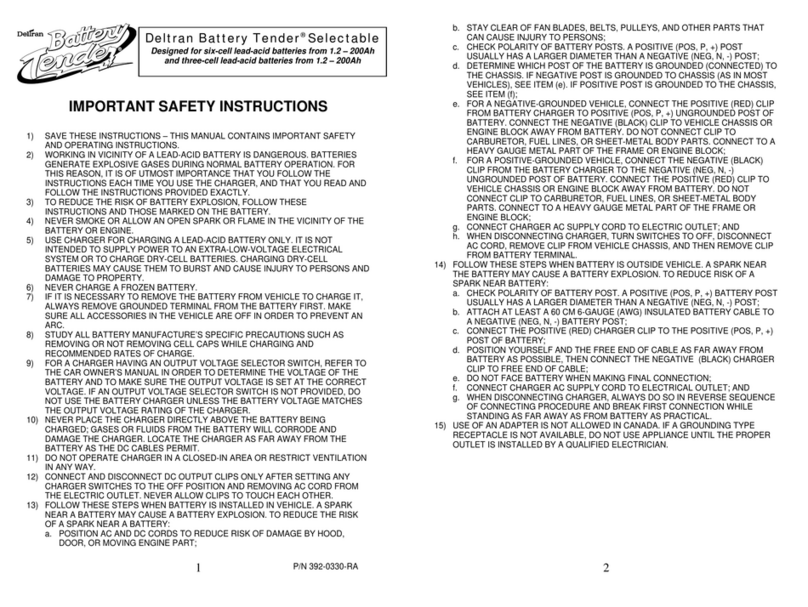
Deltran Battery Tender
Deltran Battery Tender Selectable User manual
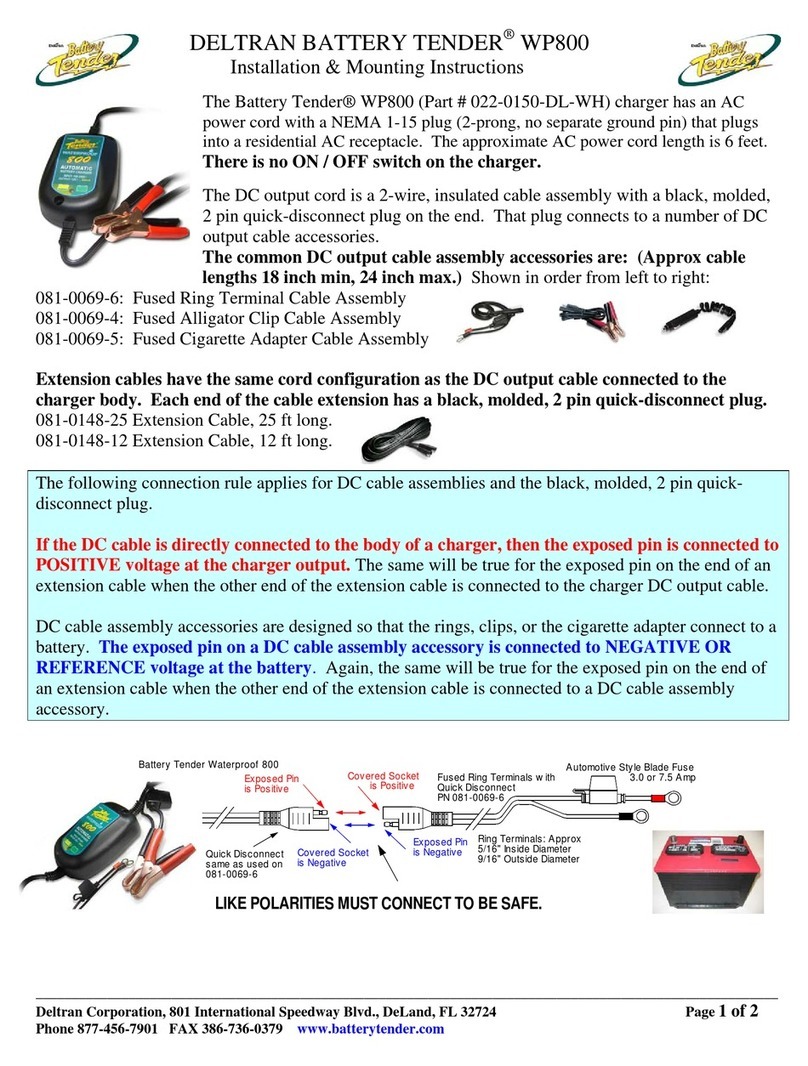
Deltran Battery Tender
Deltran Battery Tender WP800 User manual
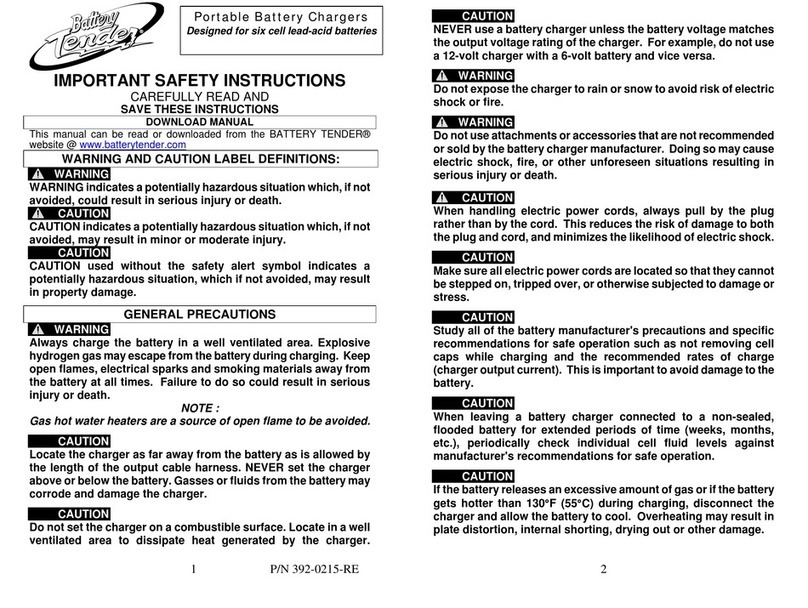
Deltran Battery Tender
Deltran Battery Tender 022-0227 User manual

Deltran Battery Tender
Deltran Battery Tender Plus User manual

Deltran Battery Tender
Deltran Battery Tender WP800 Installation instructions manual

